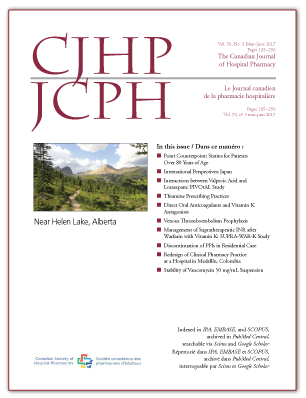Thiamine Prescribing Practices for Adult Patients Admitted to an Internal Medicine Service
DOI:
https://doi.org/10.4212/cjhp.v70i3.1657Keywords:
thiamine, vitamin B1, thiamine deficiency, Wernicke encephalopathy, alcohol-related disorders, vitamine B1, carence en thiamine, encéphalopathie de Wernicke, affections liées à l’alcoolAbstract
ABSTRACT
Background: Thiamine (vitamin B1) is an essential cofactor responsible for the breakdown of glucose, and its deficiency is associated with Wernicke encephalopathy (WE). There is a lack of evidence from systematic studies on the optimal dosing of thiamine for WE.
Objectives: The primary objective was to describe the prescribing patterns for IV thiamine in adult patients admitted to a large teaching hospital. The secondary objective was to evaluate the clinical resolution of WE symptoms (confusion, ataxia, and/or ocular motor abnormalities) in
relation to the dose of IV thiamine prescribed.
Methods: A retrospective design was used to review data for adult patients admitted to an internal medicine service from June 1, 2014, to June 30, 2015. All patients included in the study received IV thiamine: low-dose therapy was defined as 100 mg IV daily and high-dose therapy was defined as dosage greater than 100 mg IV daily.
Results: A total of 141 patients were included; low-dose thiamine was prescribed for 115 (81.6%) and high-dose thiamine for 26 (18.4%). Patients for whom high-dose thiamine was prescribed were more likely to be those in whom a diagnosis of WE was being considered (12/26
[46.2%] versus 5/115 [4.3%], p < 0.001). Of the total 219 IV thiamine doses ordered, 180 (82.2%) were for 100 mg, and 143 (65.3%) were prescribed for once-daily administration. There was no statistically significant difference in the time to resolution of WE symptoms for patients receiving high-dose versus low-dose thiamine.
Conclusions: A wide variety of thiamine prescribing patterns were noted. This study did not show a difference in time to resolution of WE symptoms in relation to the dose of IV thiamine. Additional large-scale studies are required to determine the optimal dosing of thiamine for WE.
RÉSUMÉ
Contexte : La thiamine (vitamine B1) est un cofacteur essentiel responsable du métabolisme du glucose. Une carence en thiamine est associée à l’encéphalopathie de Wernicke (EW). Or, on observe une absence de données probantes provenant d’analyses systématiques portant sur la
posologie optimale de thiamine dans le traitement de l’EW.
Objectifs : L’objectif principal était de décrire les habitudes de prescription de thiamine à administrer par voie intraveineuse chez les patients adultes admis dans un important hôpital universitaire. L’objectif secondaire était d’évaluer la disparition clinique des symptômes de l’EW (confusion, ataxie ou troubles moteurs oculaires) en fonction de la dose prescrite de thiamine à administrer par voie intraveineuse.
Méthodes : Un plan d’étude rétrospectif a été utilisé pour étudier les données concernant les patients adultes admis à un service de médecine interne entre le 1er juin 2014 et le 30 juin 2015. Tous les patients à l’étude ont reçu de la thiamine par voie intraveineuse : le traitement à faible dose était de 100 mg par jour et le traitement à dose élevée excédait 100 mg par jour.
Résultats : Au total, 141 patients ont été admis à l’étude; l’on a prescrit une faible dose de thiamine à 115 (81,6 %) d’entre eux et une dose élevée aux 26 (18,4 %) autres. Les patients qui se sont vus prescrire une dose élevée de thiamine étaient vraisemblablement ceux pour qui l’on envisageait un diagnostic d’EW (12/26 [46,2 %] contre 5/115 [4,3 %], p < 0,001). Pour l’ensemble des 219 doses prescrites de thiamine à administrer par voie intraveineuse, 180 (82,2 %) étaient de 100 mg et 143 (65,3 %) devaient être injectées à une fréquence uniquotidienne. On n’a relevé aucune différence statistiquement significative quant au temps de disparition des symptômes de l’EW entre les patients ayant reçu une dose élevée de thiamine et ceux en ayant reçu une faible dose.
Conclusions : On a noté une grande variété d’habitudes de prescription de la thiamine. La présente étude n’a pas montré que la dose de thiamine administrée par voie intraveineuse changeait le temps nécessaire à la disparition des symptômes de l’EW. Il est nécessaire de mener de plus amples études à grande échelle afin de déterminer quelle est la posologie optimale de thiamine dans le traitement de l’EW.
Downloads
Published
Issue
Section
License
Copyright © Canadian Society of Healthcare-Systems Pharmacy.
After publication of a manuscript in the CJHP, the authors of the manuscript must obtain written permission from the CSHP (publications@cshp.ca) before reproducing any text, figures, tables, or illustrations from the work in future works of their own. If a submitted manuscript is declined for publication in the CJHP, all said rights shall revert to the authors. Please note that any forms (e.g., preprinted orders and patient intake forms) used by a specific hospital or other health care facility and included as illustrative material with a manuscript are exempt from this copyright transfer. The CJHP will require a letter from the hospital or health care facility granting permission to publish the document(s).










